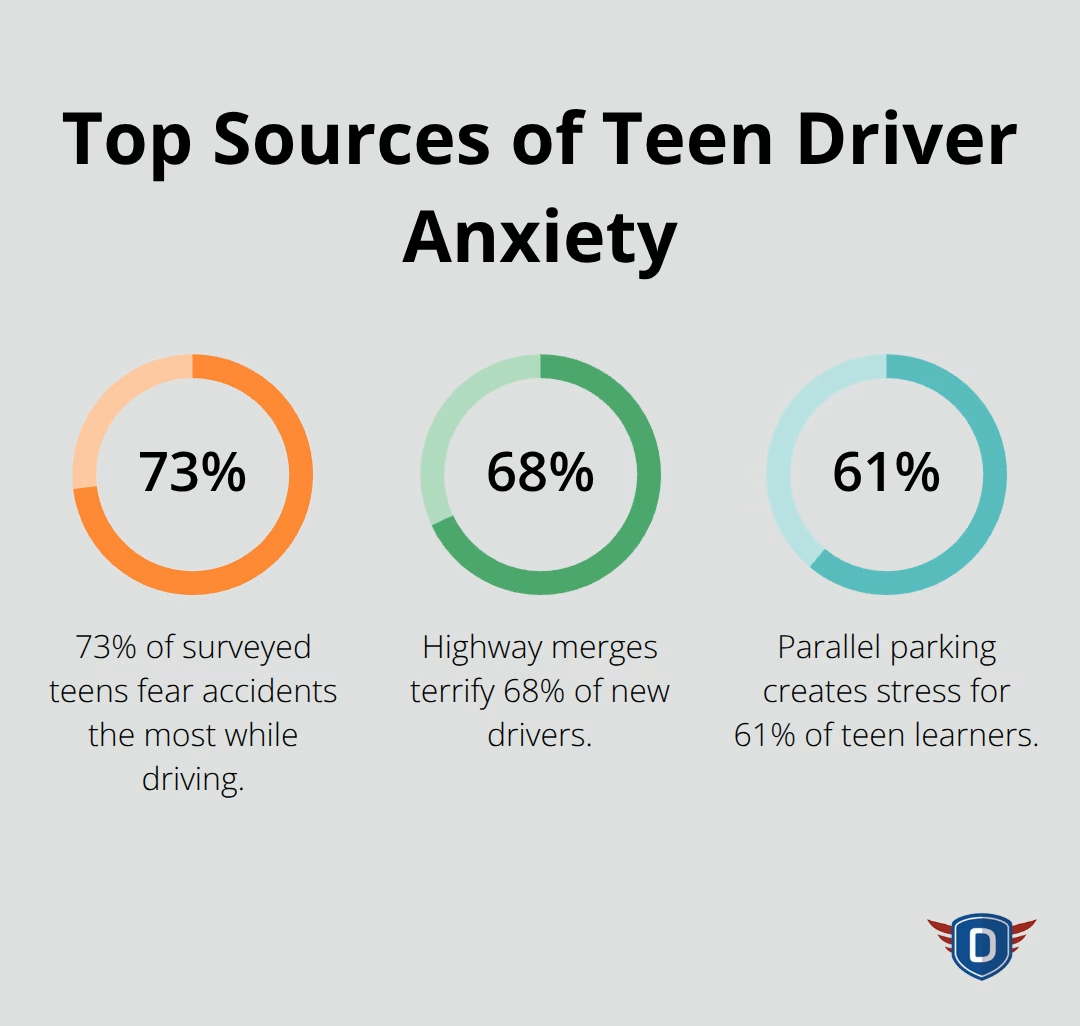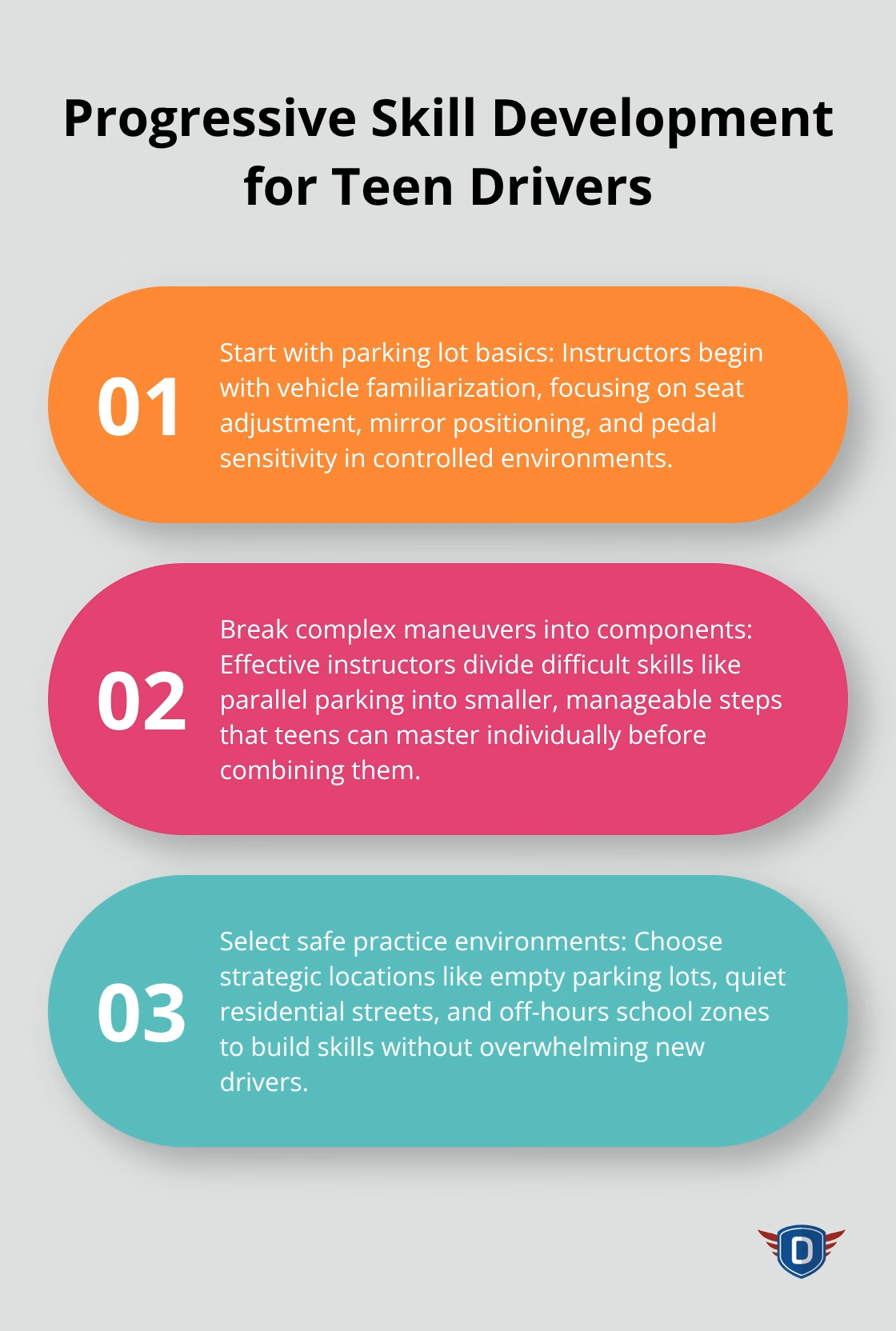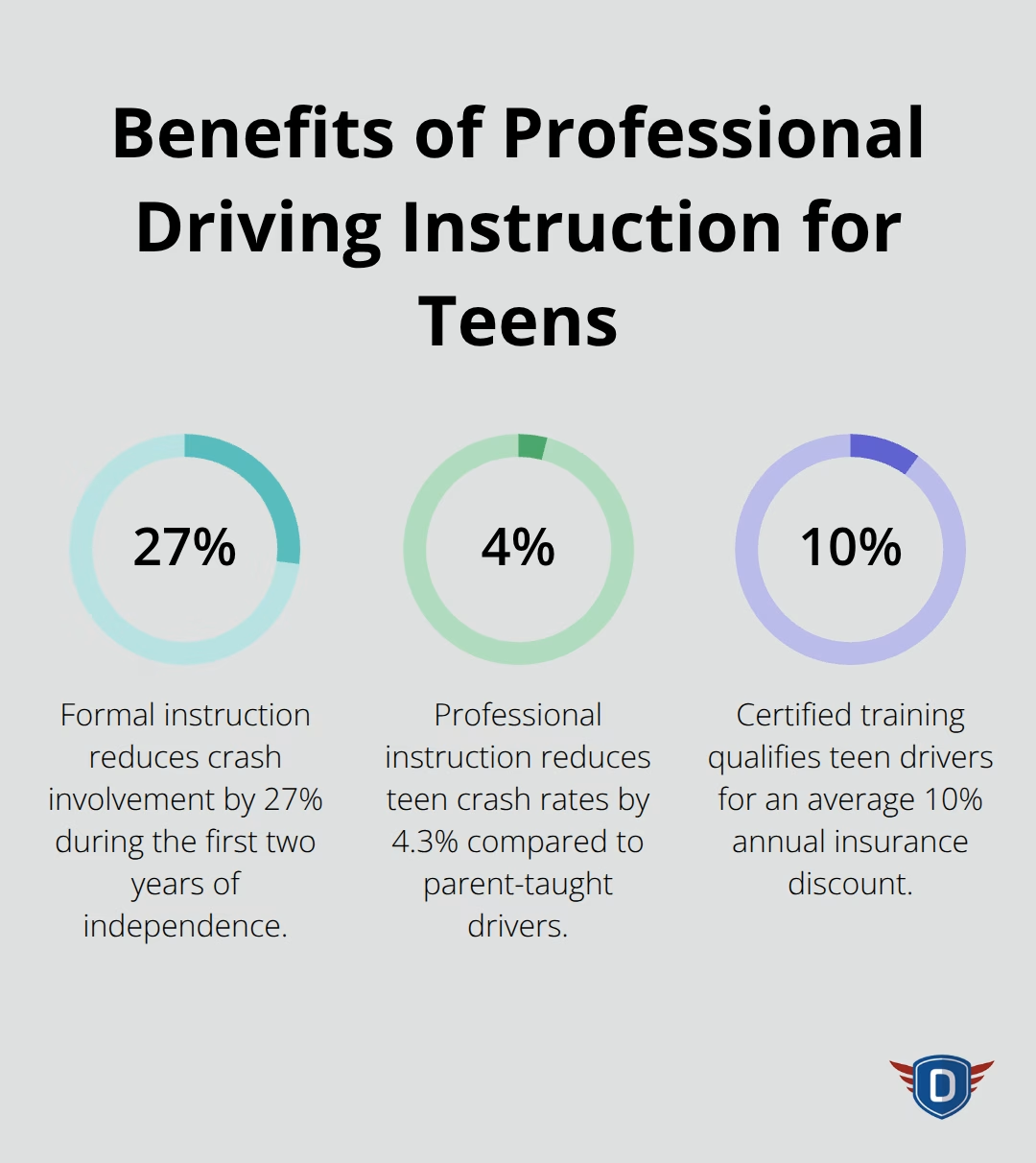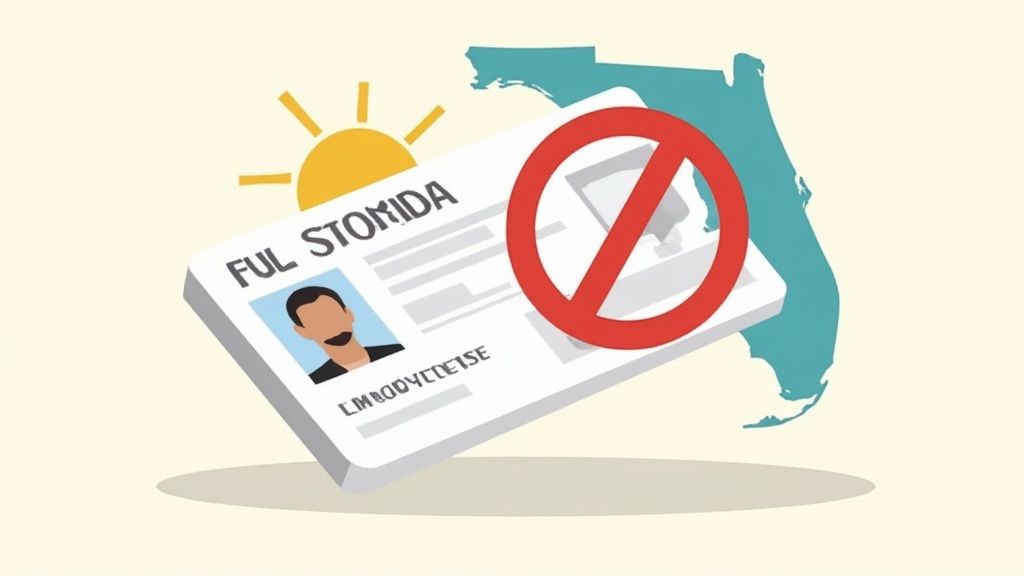Teen drivers face a 60% higher crash risk during their first year behind the wheel compared to experienced drivers. The statistics highlight why proper instruction matters more than ever.
At DriverEducators.com, we understand that driving lessons for teenagers require specialized approaches that address both technical skills and emotional readiness. Building confidence starts with the right foundation.
What Makes Teen Drivers So Anxious?
Teen anxiety behind the wheel comes from three major sources that parents and instructors must address directly. The National Highway Traffic Safety Administration reports that 40% of teenagers experience significant anxiety about the road, with fear of accidents at the top of the list for 73% of surveyed teens. Highway merges terrify 68% of new drivers, while parallel parks create stress for 61% of learners. Night conditions and adverse weather rank high on the anxiety scale, affecting 58% and 52% of teen drivers respectively.

Physical Coordination Challenges
Teen brains don’t fully develop until age 25, particularly in areas that control decision-making and risk assessment. This biological reality means teenagers struggle to coordinate multiple tasks simultaneously while they drive. Teen drivers have crash rates nearly 4 times those of drivers 20 and older per mile driven, with immaturity leading to speeding and other risky habits. Hand-eye coordination issues plague new drivers during park maneuvers, with 67% of test failures attributed to spatial awareness problems. Muscle memory for basic controls like steering, brakes, and acceleration takes approximately 40 hours of practice to develop properly.
Social Pressure Impact
Peer expectations create dangerous behaviors among teenagers, with 84% of teen drivers who admit they feel pressure to drive aggressively to impress friends. Research shows that teenage passengers increase crash risk when teen drivers carry passengers compared with driving by themselves. Social media compounds this pressure, as teens post about their experiences and compare themselves to peers. Parents who criticize performance in front of others increase anxiety levels by 35% (according to recent behavioral studies). Professional instruction eliminates this family tension while it provides objective feedback that builds genuine confidence rather than false bravado.
Fear of Judgment and Failure
Test anxiety affects 78% of teen drivers before their license exam, with many students who report sleepless nights and physical symptoms. The fear of public embarrassment during practice sessions prevents many teens from asking important questions. Instructor patience becomes vital here, as harsh criticism can set back progress by weeks. Students who receive consistent encouragement show 45% faster skill development compared to those who face constant correction. This anxiety often stems from perfectionist tendencies that many high-achieving teens carry into their lessons.
These deep-rooted anxieties require specific teaching methods that address both emotional and technical aspects of learning to drive.
How Should Instructors Build Teen Driver Confidence?
Successful teen instruction demands a methodical approach that starts with parking lot basics before advancing to complex traffic scenarios. The Insurance Institute for Highway Safety found that teens who master foundational skills in controlled environments show 43% better performance during road tests compared to those who jump straight into traffic. Professional instructors begin with vehicle familiarization and spend the first lesson on seat adjustment, mirror positioning, and pedal sensitivity. The second lesson focuses exclusively on straight-line movement and basic turns in empty spaces. Week three introduces reverse maneuvers, while highway merges wait until lesson eight or later.

Progressive Skill Development Creates Success
Effective instructors break complex maneuvers into smaller, manageable components that teens can master individually. Students learn parallel parking through five distinct steps: approach positioning, initial reverse, wheel adjustment, final positioning, and straightening. Each component receives dedicated practice time before instructors combine them into the complete maneuver. This systematic approach reduces overwhelm and allows teens to build confidence through repeated success with individual elements.
Safe Environment Selection Drives Results
Professional schools choose practice locations strategically and avoid busy intersections and high-traffic areas during initial lessons. Research from the National Highway Traffic Safety Administration shows that unsafe drivers exhibit more hard deceleration, acceleration, and swerve maneuvers during baseline driving than safe drivers. Shopping center parking lots after hours provide ideal spaces for basic maneuvers. Quiet residential streets with minimal traffic work perfectly for stop sign practice and lane positioning. School zones during off-hours offer controlled intersection experience without overwhelming stimulus.
Positive Feedback Accelerates Progress
Instructors who focus on specific achievements rather than general praise see dramatically better results with anxious teen drivers. The American Driver and Traffic Safety Education Association reports that students who receive targeted feedback improve reaction times by 52% over six weeks. Instead of saying “good job,” effective instructors point out exact improvements like smoother braking or better mirror checks. Correction should immediately follow recognition of what the student did correctly. Students who hear three positive observations for every correction show measurably higher confidence levels and pass tests at rates 29% higher than those who receive primarily negative feedback.
Patience and Repetition Build Mastery
Teen drivers need multiple exposures to the same skill before they achieve competency (typically 15-20 repetitions for basic maneuvers). Instructors who rush through lessons create anxiety and incomplete learning. Professional instructors allow adequate time for each skill and repeat exercises until students demonstrate consistent performance. This patience pays dividends when teens face their road tests with genuine confidence rather than false assurance.
While these teaching methods form the foundation of effective instruction, the expertise and training that certified instructors bring to the process makes the difference between adequate and exceptional results.
Why Professional Instructors Beat Family Teaching
Professional instructors deliver measurably superior results compared to parent-taught drivers, with formal instruction reducing teen crash rates by 4.3%. Teenagers who complete structured driver education programs show fewer convictions and demonstrate significantly better hazard recognition skills two years after licensing. Professional instructors maintain emotional neutrality that parents cannot match, which eliminates the family tension that derails most parent-taught lessons.
Certified Training Creates Real Expertise
State-certified instructors complete rigorous training programs that average 240 hours of coursework plus ongoing education requirements that most parents never receive. These professionals understand teen brain development and adapt their teaching methods accordingly, while parents often apply adult learning assumptions that frustrate teenagers. Certified instructors recognize the warning signs of anxiety and know exactly when to slow down or change approaches. Instructor-trained teens demonstrate better emergency response times compared to family-taught drivers during their first year of independence.
Structured Programs Eliminate Gaps
Professional schools follow state-mandated curricula that cover every essential skill systematically, while family instruction often skips critical areas like defensive techniques or adverse weather handling. Parent-taught drivers miss required safety topics during their informal lessons. Professional programs dedicate specific time blocks to parallel parking, highway merges, and intersection navigation that parents frequently avoid due to their own discomfort. Students who complete formal programs score higher on written exams and show superior vehicle control during practical assessments.
Family Dynamics Sabotage Learning
Parent-teen lessons create stress that hinders skill development, with most families reporting arguments during practice sessions. Professional instructors eliminate this emotional baggage and provide objective feedback that teens accept more readily than parental criticism. Teens who learn from certified instructors show faster progress rates and require fewer total practice hours before they achieve road test readiness compared to family instruction. Professional instruction also improves family relationships by removing conflicts that strain parent-teen bonds during this critical developmental period.
Final Thoughts
Professional driving lessons for teenagers create benefits that extend far beyond the road test. Students who complete structured programs maintain lower accident rates throughout their careers, with formal instruction that reduces crash involvement by 27% during the first two years of independence. These drivers develop superior hazard recognition skills that protect them for decades.

The financial investment in professional instruction pays substantial dividends over time. Teen drivers who receive certified training qualify for insurance discounts that average 10% annually (saving families approximately $300 over three years). More importantly, the accident prevention benefits can save thousands in potential collision costs and medical expenses.
Quality instruction builds habits that last a lifetime. Professional programs teach defensive techniques and safety awareness that become automatic responses during emergencies. At DriverEducators.com, we focus on creating confident drivers who prioritize safety throughout their careers. The Florida New Driver have the steps to get your driver’s license in Florida.





